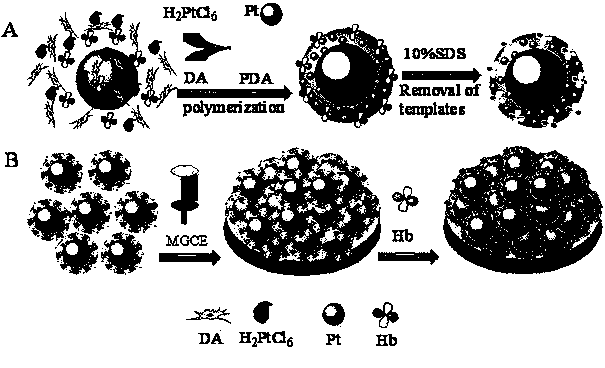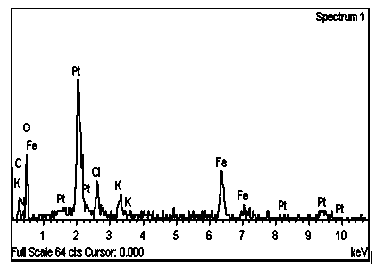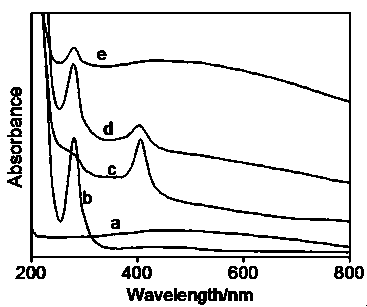Construction and application of impedance type electrochemical sensor based on molecularly imprinted polymer with magnetic surface
A technology of surface molecular imprinting and magnetic molecular imprinting, which is applied in the field of electrochemical sensing, can solve the problems of difficult large-scale production, difficulty in entering and exiting recognition sites of template molecules, and low cost. The effect of identifying and improving electron conductivity
- Summary
- Abstract
- Description
- Claims
- Application Information
AI Technical Summary
Problems solved by technology
Method used
Image
Examples
Embodiment 1
[0021] (1) Fe 3 o 4 Preparation of magnetic nanoparticles: 1.35 g of ferric chloride hexahydrate was dissolved in 40 mL of ethylene glycol solution, and then 1.0 g of polyethylene glycol and 3.6 g of sodium acetate trihydrate were added. After the above mixed solution was ultrasonically stirred for 1 hour, it was transferred to a polytetrafluoroethylene autoclave and heated at 180 oC for 6 hours. The collected product was washed three times with ethanol and ultrapure water, and dried at 60 oC in a vacuum oven. After 12 hours, Fe with a particle size of 80-120 nm can be produced 3 o 4 magnetic nanoparticles;
[0022] (2) if figure 1(A) Shown, the preparation of magnetic molecularly imprinted polymers: the Fe 3 o 4 , dopamine and Hb were dissolved in 20 mL of PBS buffer solution with pH 6.98, and then 2.1 mL of 2% chloroplatinic acid was added, mechanically stirred at 4 °C for 30 minutes, and then stirred at room temperature for 2 hours. The reaction product was collected...
Embodiment 2
[0027] like figure 1 As shown in (B), the construction of resistive electrochemical sensor based on molecularly imprinted polymers on the magnetic surface: the magnetic glassy carbon electrode was sequentially polished with 1.0, 0.3 and 0.05 μm alumina suspensions, and then sequentially washed with 0.1 mol / L Wash with nitric acid, absolute ethanol and ultrapure water, dry the electrode with nitrogen, drop 10 μL magnetic molecular imprinted polymer suspension on the electrode surface, dry it naturally and wash it with secondary water to obtain molecular imprinting based on magnetic surface. Polymer resistive electrochemical sensors.
[0028] Cyclic voltammetry and AC impedance method ( Figure 4 ) to characterize the performance of the sensing interface. Fe 3 o 4 / PDA-PtNPs-Hb / MGCE has a pair of obvious redox peaks in PBS, when Hb is eluted, Fe 3 o 4 The redox peaks of / PDA-PtNPs / MIPs / MGCE disappeared. Depend on Figure 4 Visible, Fe 3 o 4 / PDA-PtNPs-Hb / MGCE has a lar...
Embodiment 3
[0030] Application of resistive electrochemical sensors based on magnetic surface molecularly imprinted polymers: the prepared sensors were placed in solutions containing different concentrations of Hb for 15 minutes, and the electrode surface was washed with 10 mM pH 6.98 phosphate buffer solution, and the electrode surface was washed with 5.0 mM Fe(CN) 6 4- / 3- Measure the AC impedance of the sensor for the electrochemical probe; with the increase of Hb, the Hb bound to the sensing interface increases, and the impedance of the sensor increases ( Figure 5 ). There was a good linear relationship between AC impedance value and Hb concentration in the range of 0.14 μg / mL-2.7 μg / mL, and the detection limit was 0.05 μg / mL (S / N). Fe 3 o 4 / PDA-PtNPs / NIPs / MGCE was soaked in different concentrations of Hb solutions for 15 minutes, and the recorded impedance values did not change much, indicating that the effect of non-specific adsorption was small. The sensor constructed by th...
PUM
| Property | Measurement | Unit |
|---|---|---|
| Particle size | aaaaa | aaaaa |
Abstract
Description
Claims
Application Information
 Login to View More
Login to View More - R&D
- Intellectual Property
- Life Sciences
- Materials
- Tech Scout
- Unparalleled Data Quality
- Higher Quality Content
- 60% Fewer Hallucinations
Browse by: Latest US Patents, China's latest patents, Technical Efficacy Thesaurus, Application Domain, Technology Topic, Popular Technical Reports.
© 2025 PatSnap. All rights reserved.Legal|Privacy policy|Modern Slavery Act Transparency Statement|Sitemap|About US| Contact US: help@patsnap.com



